
views
Checking a Cat’s Temperature
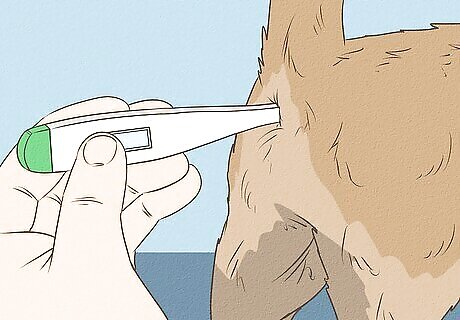
Use a pediatric rectal thermometer to take your cat’s temperature. Place a disposable sleeve on the digital thermometer and cover the stem with a water-based lubricating jelly. Hold your cat under one arm with their tail facing in front of you and their feet on a table. Insert the thermometer 1 inch (2.5 cm) into the cat’s anus until it beeps. This is the most effective and trustworthy way to get a cat’s temperature. Ask a friend to help you hold the cat if possible. If you have a squirmy kitty, gently wrap them up in a towel with their behind exposed. Hold the thermometer at a 90-degree angle and try not to angle it or push it into the rectum more than 1 inch (2.5 cm). Try to avoid using a glass thermometer containing mercury. If you only have a glass thermometer on hand, insert it as directed above and hold it in for 3 minutes. After you’re done, throw away the disposable sleeve and use warm soapy water or rubbing alcohol to wash the end of the thermometer.
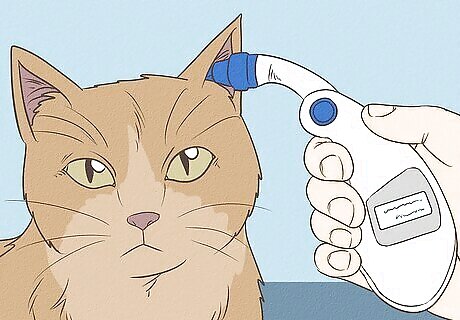
Use an ear thermometer to check your cat’s temperature. Hold your cat’s head with one hand, stroking their chin while supporting their body with your arm and their feet on the table. Turn on the ear thermometer and place it into the cat’s ear canal, holding it there until it beeps. If your cat wriggles a lot, wrap them up in a soft towel or blanket and lower your body towards the cat, using your hands to hold their head still and give them soft strokes. If you have a friend available, have them take your cat’s temperature while you hold them still. After you’re done taking your cat’s temperature, clean the thermometer thoroughly with warm soapy water or rubbing alcohol before putting it away.
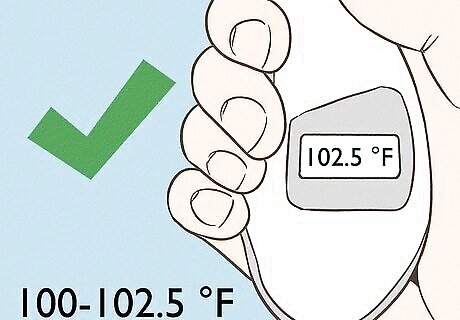
A cat’s normal temperature is 100 to 102.5 °F (37.8 to 39.2 °C). If your cat’s temperature is below or above that range, wait 15 minutes and take their temperature again to get an accurate reading. If the reading stays the same, book an appointment with your vet right away. If you see blood, diarrhea, or black, tarry stool on the thermometer, that’s also a sign to take your cat to the vet right away.
Symptoms of a Fever in Cats

Your cat’s eating and playing behaviors may change suddenly. Veterinarian Dr. Brian Bourquin says that some cats with a fever might “wobble, often hide,” “avoid wanting to be touched,” or have “a dry nose… because the cat will be dehydrated.” He also says “If a fever is high enough, you can sometimes even notice the difference by holding the cat. They'll feel warmer to you.” Other signs of fever include: Loss of appetite Weakness or lethargy Rapid heart rate Decreased activity or grooming Shivering or rapid breathing Vomiting, diarrhea, or sneezing Glassy or red and watery eyes However, Dr. Brian Bourquin also says “You may not see any signs of fever at all. The only way to say for sure whether a cat has a fever is to take [their] rectal temperature.”
Why does my cat have a fever?
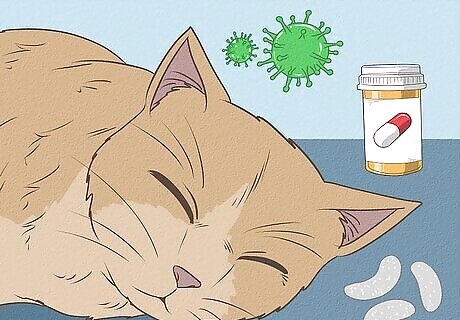
Fevers are most commonly caused by infections and diseases. Bartonella (cat scratch disease), tularemia, and other infectious diseases can cause fever in cats. Outdoor cats that come into contact with rats and other animals might be the most at-risk for exposure to these diseases. Fevers can also be caused by: Fungal, bacterial, or viral infections Infections and abscesses Parasitic diseases like toxoplasmosis Certain medications Injury Tumors
When is it time to take my cat to a vet?
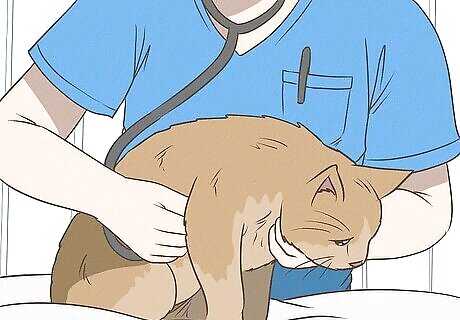
Take your cat to a vet if their temperature is above or below normal. Cats can overcome a fever on their own if they have a mild sickness, but it’s always a good idea to consult your vet to make sure it isn’t a sign of a larger issue. If your cat’s behavior or eating habits change dramatically, visit a vet right away. If your cat’s fever stays above 100 to 102.5 °F (37.8 to 39.2 °C) for longer than 24 hours, take your cat to an emergency vet clinic. Tell your vet about any other symptoms your cat exhibits so they can determine a diagnosis. If the cause of your kitty’s fever cannot be determined, they might be diagnosed with a fever of unknown origin (FUO), which may be treated with antibiotics first.
Caring for a Cat with a Fever at Home

Follow the vet’s instructions when administering medication. To administer medicine, put your non-dominant hand on the top of their head with your thumb on one side of their cheek and your fingers on the other. Gently tilt their head back so their nose is toward the ceiling, gently apply pressure with your dominant hand to open their mouth. Pills and tablets: Quickly place them onto the tongue as far back as you can, then close their mouth and hold it until you see your cat swallow. Liquid medicines: Insert the syringe or dropper in the side of their mouth behind their large fangs. If your vet says to put the tablet in food, crush it and mix it into their meal or put it inside a soft, tasty cat treat.

Make sure your cat has easy access to fresh clean water. If your cat is drinking less water, gently encourage them by making sure you have several water bowls so your cat doesn’t have to go far and trying other liquids like water from a can of tuna or meat broths. Place one water bowl on each level in your house so your cat doesn’t have to go up or downstairs to drink. Put water bowls away from their food bowls, in a quiet location away from doors or especially busy places. Try to avoid giving your cat salty liquids, milk, or anything containing onions or onion powder.

Most fevers go away in a day or two, but it depends on your cat’s condition. If your cat has a minor illness or infection, they might recover quickly after starting treatment with a vet. However, serious conditions could take weeks to months or require multiple approaches until your kitty’s symptoms go away. Some extreme viruses, like Feline Leukemia Virus (FelV) or Feline Immunodeficiency Virus (FIV) have no cure but can be alleviated with medications.




















Comments
0 comment